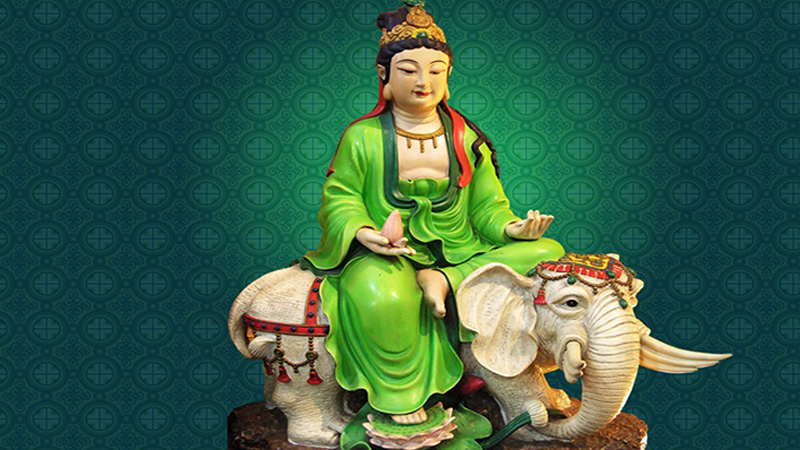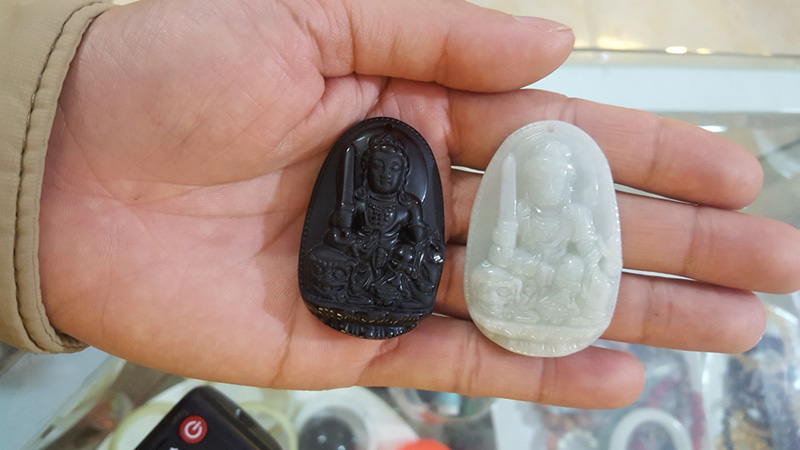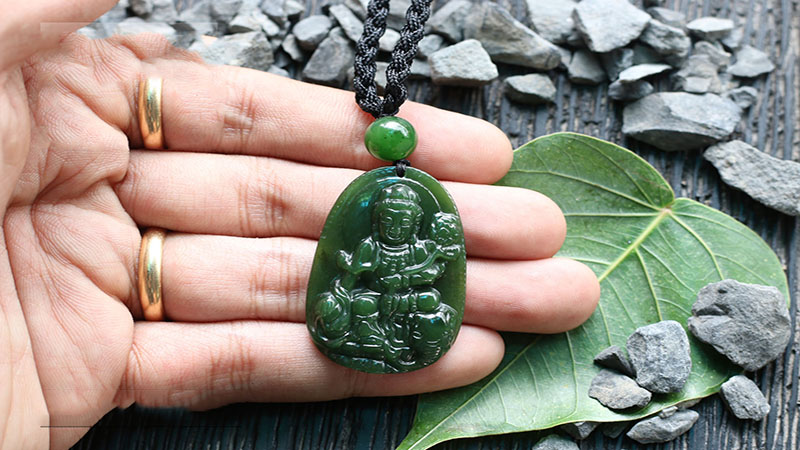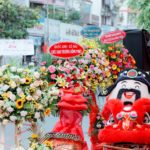The Bodhisattva Samantabhadra, also known as the Bodhisattva of Great Vehicle Buddhism, is revered in Mahayana Buddhism. As such, he is also considered a symbol of prosperity and good fortune in Feng Shui. Join us as we explore the meaning of Samantabhadra Bodhisattva in Feng Shui and discover how he can bring blessings into your life.
1. Who is Samantabhadra Bodhisattva?
Status
Samantabhadra Bodhisattva, also known as Tam-man-da Bat-da-la, was the fourth son of King Vo Tranh Niem before he left his royal life to pursue the path of Buddhism. He later became one of the most revered Bodhisattvas in Mahayana Buddhism. Samantabhadra Bodhisattva represents equality, wisdom, and understanding, embodying the principles of reason, meditation, and virtue. He is believed to possess the wisdom, meditation, and virtue of the Buddha.
Samantabhadra Bodhisattva is one of the four great Bodhisattvas in Buddhism, alongside Avalokitesvara, Manjusri, and Ksitigarbha. He and Manjusri are believed to be the two primary attendants of Shakyamuni Buddha. Samantabhadra Bodhisattva is often depicted riding a six-tusked white elephant, with his hands clasped together in a gesture of reverence.
Symbolism
Samantabhadra Bodhisattva is a symbol of wisdom and strength. Riding a six-tusked white elephant, he represents the unity of reason, meditation, and action. The six tusks of the elephant symbolize the victory over the six senses, while the white color represents purity and wisdom. Samantabhadra Bodhisattva is often depicted with a solemn and dignified expression, emphasizing his role as a guide and protector.
 An Overview of Samantabhadra Bodhisattva
An Overview of Samantabhadra Bodhisattva
Legend
Before leaving his royal life to pursue the path of Buddhism, Samantabhadra was known as Nang-da-no, the fourth son of King Vo Tranh Niem. Following the advice of his father, the young prince decided to make offerings to the Buddha and all sentient beings for three months. During this time, a high-ranking official named Bao Hai noticed his devotion and encouraged him to dedicate his life to the path of Bodhisattva and strive for enlightenment.
Upon hearing these words of wisdom, Prince Nang-da-no immediately made a vow to the Buddha Bao Tang, declaring his aspiration to attain Bodhi and become a Bodhisattva. The Buddha Bao Tang, impressed by the prince’s sincerity, bestowed upon him the name “Kim Cang Tri Hue Quang Minh Cong Duc”, which translates to “Vajra Wisdom光明功德.” Through his dedication and meritorious deeds, Samantabhadra eventually attained Buddhahood and became known as the Samantabhadra Tathagata in the world of Bat Huyen.
Samantabhadra is believed to have diligently practiced to become a Buddha in the realm of Bat Huyen. He is said to have manifested himself in various forms throughout the world to teach and guide sentient beings toward enlightenment.
The Ten Great Vows of Samantabhadra Bodhisattva
The Ten Great Vows of Samantabhadra Bodhisattva are as follows:
- Sincerely paying homage to all Buddhas.
- Praising and revering the Tathagatas.
- Practicing generous offerings.
- Repenting and purifying negative karma.
- Rejoicing in the virtues of others.
- Requesting the Buddhas to teach the Dharma.
- Inviting the Buddhas to remain in the world.
- Following the teachings of the Buddha diligently.
- Benefiting all sentient beings.
- Dedicating all merits to the liberation of all beings.
2. The Meaning of the Name Samantabhadra
 The Meaning of the Name Samantabhadra Bodhisattva
The Meaning of the Name Samantabhadra Bodhisattva
When translated, the name Samantabhadra has the following meanings: “Samanta” means “all-pervading,” and “Bhadra” means “Enlightened Being.” Thus, Samantabhadra can be understood as the Enlightened Being who has the power to manifest everywhere, responding to the wishes and needs of all sentient beings.
The statues and images of Samantabhadra Bodhisattva often depict him with a benevolent and dignified expression, adorned with exquisite jewelry. He is typically shown riding a six-tusked white elephant, with one hand holding a lotus flower and the other carrying a precious jewel. These symbols represent his compassion and dedication to saving all beings from suffering, guiding them away from pitfalls, and bringing good fortune in all aspects of life.
3. Distinguishing Samantabhadra Bodhisattva from Manjusri Bodhisattva
Manjusri Bodhisattva is often depicted as a youthful figure, holding a flaming sword in his right hand, raised high above his head. In his left hand, he embraces the Prajnaparamita Sutra, pressing it against his heart. Manjusri is often shown seated on a blue lion, symbolizing his dominance over the spiritual realm. He also wears the armor of patience, which protects him from the arrows of slander and false accusations.
Samantabhadra Bodhisattva, on the other hand, is usually depicted with a royal crown and adorned with precious jewels. He rides a six-tusked white elephant, a symbol of wisdom and strength. In his left hand, he holds a precious jewel or a lotus flower with a jewel on top. The elephant represents his ability to overcome obstacles and achieve enlightenment.
 Distinguishing Samantabhadra Bodhisattva and Manjusri Bodhisattva
Distinguishing Samantabhadra Bodhisattva and Manjusri Bodhisattva
4. Samantabhadra Bodhisattva Jewelry for Different Ages and Destinies
 Ages and Destinies Suited for Samantabhadra Bodhisattva Jewelry
Ages and Destinies Suited for Samantabhadra Bodhisattva Jewelry
Samantabhadra Bodhisattva is believed to bring good fortune and protection to those born in the years of the Dragon and Snake in the Chinese zodiac.
For those born in the year of the Dragon: 1940 (Canh Thìn), 1952 (Nhâm Thìn), 1964 (Giáp Thìn), 1976 (Bính Thìn), 1988 (Mậu Thìn).
For those born in the year of the Snake: 1941 (Tân Tỵ), 1953 (Quý Tỵ), 1965 (Ất Tỵ), 1977 (Đinh Tỵ), 1989 (Kỷ Tỵ).
5. Choosing Samantabhadra Bodhisattva Jewelry
 Choosing Samantabhadra Bodhisattva Jewelry for Different Destinies
Choosing Samantabhadra Bodhisattva Jewelry for Different Destinies
For people born in the year of the Dragon, the following jewelry choices are recommended based on their birth year:
- For those born in 1964 (Giáp Thìn) with a Fire destiny, choose Samantabhadra Bodhisattva jewelry in red or green colors, made from red agate or green jade.
- For those born in 1976 (Bính Thìn) with an Earth destiny, select jewelry in red or brownish-yellow colors, crafted from red agate or tiger’s eye stone.
- For those born in 1988 (Mậu Thìn) with a Wood destiny, opt for jewelry in green or black colors, made from green jade or obsidian.
- For those born in 2000 (Canh Thìn) with a Metal destiny, choose jewelry in brownish-yellow, gold, or white colors, crafted from tiger’s eye, white agate, or white jade.
For people born in the year of the Snake, the following jewelry choices are recommended based on their birth year:
- For those born in 1965 (Ất Tỵ) with a Fire destiny, choose Samantabhadra jewelry in red or green colors, made from red agate or green jade.
- For those born in 1977 (Đinh Tỵ) with an Earth destiny, select jewelry in brownish-yellow or red colors, crafted from tiger’s eye or red agate.
- For those born in 1989 (Kỷ Tỵ) with a Wood destiny, opt for jewelry in green or black colors, made from green jade or obsidian.
- For those born in 2001 (Tân Tỵ) with a Metal destiny, choose jewelry in brownish-yellow, gold, or white colors, crafted from tiger’s eye, white agate, or white jade.
6. Important Considerations When Wearing Samantabhadra Bodhisattva Jewelry
 Considerations When Wearing Samantabhadra Bodhisattva Jewelry
Considerations When Wearing Samantabhadra Bodhisattva Jewelry
When wearing Samantabhadra Bodhisattva jewelry, it is important to keep the following in mind:
- Maintain a virtuous and compassionate mindset. Avoid engaging in harmful or unethical actions.
- Keep the jewelry in a clean and respectful place, away from unwholesome environments.
- Ensure that the jewelry remains clean and free from dirt or grime.
- Avoid letting strangers touch your Samantabhadra Bodhisattva jewelry, as it is believed to be sacred and personal.
- When not wearing the jewelry, wrap it in a red or yellow cloth and store it in a clean and safe place.
- To clean your Samantabhadra Bodhisattva jewelry, use a soft cloth, warm water, and sandalwood incense to gently wipe it down.
We hope that this guide has provided you with a deeper understanding of the significance of Samantabhadra Bodhisattva in Feng Shui. For further insights, continue exploring our website, where we delve into the world of Buddhist symbolism and its practical applications in daily life.
2023 Lunar New Year Gift Ideas for Older Family and Friends
As 2021 approaches, families worldwide are gathering to celebrate the special bond between grandparents and their grandchildren. To show their love and admiration, these thoughtfully chosen gifts will bring a smile to the face of the elderly. Here, we have compiled a list of the 13 most meaningful Tet presents that can bring joy to our beloved grandparents.



































